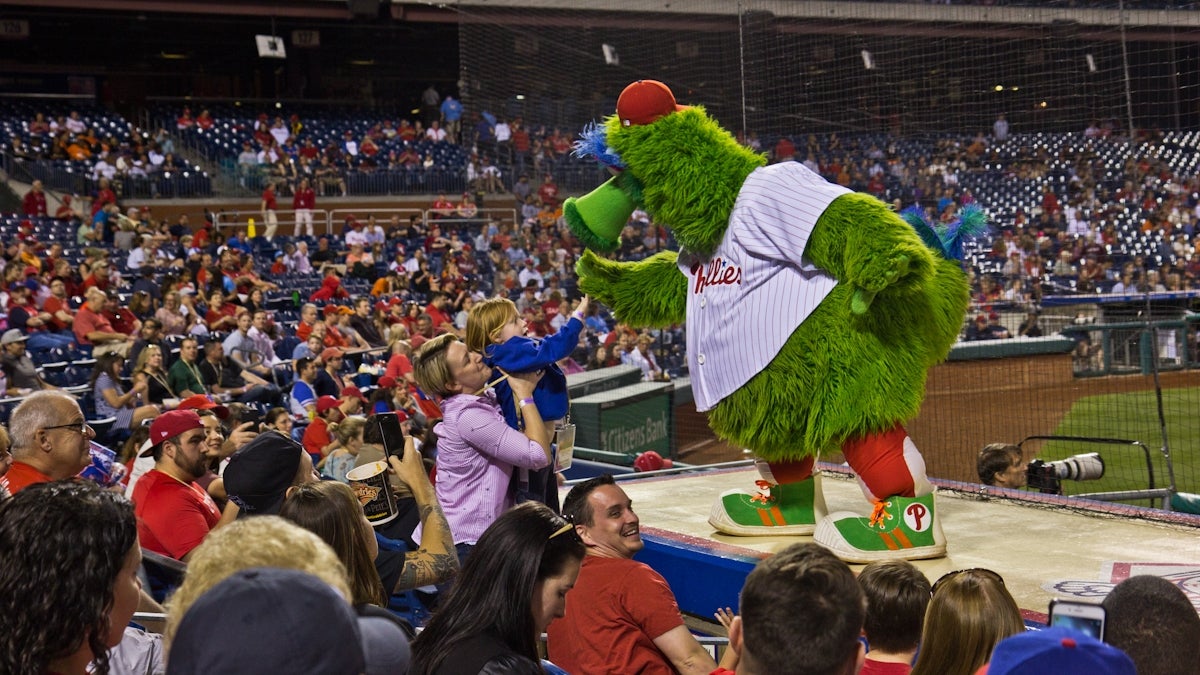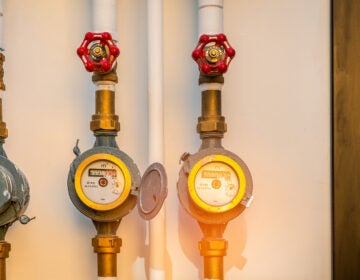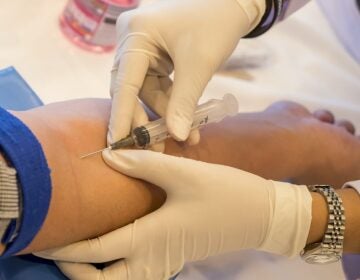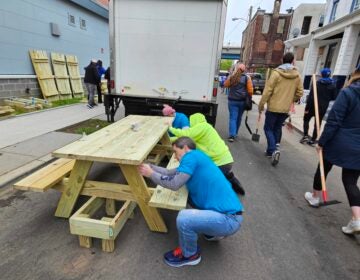Made in America: Philly’s most iconic exports

A young fan high-five's the Phillie Phanatic (Kimberly Paynter/WHYY)
Last week, the White House celebrated contributions to American greatness, showcasing products from each state as part of Made in America Week.
In that spirit we offer this list of some of Philadelphia’s most iconic exports — other than the cheesesteak.
For centuries, the Delaware Valley was a burgeoning industrial center. Our firsts, including the nation’s first hospital, first zoo, and first public library, are nothing short of inspirational. But it’s our people — their talents, personalities, and diversity — that seem to have made the most impact on modern culture over the years.
Let’s begin there.
Let us entertain (and educate) you
The creativity of Philadelphians defined the sounds of the last 60 years of popular music.Today’s “Jersey Boys” are the Golden Boys of the ’50s: Frankie Avalon, Fabian, and Bobby Rydell. Don’t leave out Eddie Fisher. And our very own “Geator with the Heater,” the “Boss with the Hot Sauce,” DJ Jerry Blavat keeps it alive and hopping to this day.
In the ’70s, Kenny Gamble and Leon Huff gave soul to The Sound of Philadelphia. Darryl Hall and John Oates topped charts in the ’70s and the’80s with their distinctive “blue-eyed soul.”
Long before all of them, opera singer Marian Anderson broke boundaries for African-American singers around the country. Ask your grandparents about her stirring outdoor performance on the steps of the Lincoln Memorial in Washington in 1939. (The Daughters of the American Revolution had previously prevented her from performing in front of a mixed-race audience elsewhere.)
Jazz legends John Coltrane and Sun Ra; Mario Lanza, Chubby Checker, Patti Labelle, Sister Sledge, Jill Scott, Leslie Odom Jr., Eve,and Boyz II Men (who just had a Philly Boulevard named after them) — all from Philly. Let’s not forget our Bucks County girl Alesha Moore, a.k.a. Pink! We’ll claim her, too.
“American Bandstand” (1952 to 1989), “Dancin’ On Air” (1981 to 1987), and the Nickelodeon classic “Double Dare” (1986 to 1993) were all homegrown television shows. “Double Dare” host Marc Summers has done a version of the classic game during Beer Week. Disappointingly, it’s not for public participation. Only area brewers get the super-sloppy honors of team-play competition.
Fun fact: The first season of “Double Dare” was actually filmed at WHYY’s television studios. (Sadly, all signs of green slime were scrubbed away decades ago.)
“It’s Always Sunny In Philadelphia” brought a renewed celebration of the city’s infamous attitude problem. Scenes are only occasionally shot on Philly’s streets, but show creator and star Rob McElhenney is from here.
The Roots (and by extension Jimmy Fallon) bring Philly funk to “The Tonight Show.”
We wouldn’t dare let a list of Philly icons go by without mentioning Terry Gross and Marty Moss-Coane. Through “Fresh Air” and “Radio Times,” they help us all understand the world a little bit better every single weekday. Neither is from Philadelphia (Terry is from Brooklyn; Marty grew up in Massachusetts and Delaware), but we forgive them. They’re ours, dammit. But we’ll share.
In television and film, comedian Kevin Hart has taken the lead as the nation’s Philly guy. He was just honored with a mural of his likeness at his neighborhood cheesesteak spot — an honor bestowed upon few.
Will Smith is and always will be a national treasure.
Bradley Cooper, Tina Fey, and M. Night Shyamalan all hail from the area and give much love back in their work. For those who want to take a hard line on Philly’s boundaries, OK: They’re suburban. But we’re claiming them as well.
While we’re at it, it can’t have escaped anyone’s attention in the last few months that Bill Cosby is a Philadelphian. We spent some time unraveling his fall from grace. (Look for more, when he gets prosecuted again in November.)
Actors Jimmy Darren, Richard Gere, and Kevin and Ed Bacon, are all Philly natives, too. (You know all of these people have to be connected to those Bacon boys somehow.)
Basketball legend Wilt “the Stilt” Chamberlain and astronaut Guion Bluford both attended Overbrook High School. Bluford graduated in 1960. Chamberlain in 1955.
Speaking of sports, don’t let’s forget, the Phillie Phanatic — the most recognizable team mascot in the history of flightless birds … and baseball. Though he hails from the Galápagos Islands, after 40 years he’s as native as it gets. He is one of only three mascots on display in the National Baseball Hall of Fame and Museum in Cooperstown, New York.
The list of famous Philadelphians who continue to leave a mark on the rest of the country could go on and on.
Household names you can’t live without
One of the nation’s largest independent coffee roasters, La Colombe, got its start right here in Rittenhouse Square. Since then it’s grown its brand and reputation to encompass 26 locations nationwide including Boston, D.C., Chicago, and Los Angeles.
A quick twist of the iconic yellow-red-and-blue wrapper reveals what’s commonly agreed to be the nation’s first successful brand of bubblegum, Fleer — now better known as Dubble Bubble. Frank Fleer founded the business in 1885, kicking off with its first patented product, a candy-coated gum, Chiclets! It wasn’t until 1928 that the first successful batch of iconic pink, stretchy, bubble gum was made.
Candy Corn, known lovingly by some as “Chicken Feed,” was also originally made in Philadelphia. Created in the 1880s by George Renninger of the Philly-based Wunderle Candy Company, the Goelitz Confectionery Company (now Jelly Belly) began production at the turn of the 20th century, though some disagreement on these details persists.
The great-great-great-grandson of Dr. Philip Syng Physick, “Father of American Surgery,” runs a small company called Dr. Physick Soda and claims to manufacture the “original” formula of soda pop — dating from back when it was prescribed as medicine (c. 1807). You can find the Physick House in Society Hill, where it was built in 1786.
On hot summer stretches, you can thank Philadelphia for both Breyer’s and Bassett’s ice cream brands, available around the country. But it’s Mr. Softee and his tell-tale jingle that is the most surprising sweet summer treat that got it’s start here in the city.
Back in 2015 Philly Mag put together a list of iconic Philly food inventions, including Sweetzel’s Spiced Wafers, Taylor Pork Roll, soft pretzels, hoagies, Goldenberg’s Peanut Chews, Tastykake, and a handful more. We won’t steal their thunder here. Check out their article instead.
We built this city on innovation
Philadelphia has long been a home to American entrepreneurial ingenuity. But we don’t just build products — we also help shape the character of the nation.
Jack & Jill of America, an African-American social and service club has over 230 chapters nationwide. It was founded in Philly in 1938, when “twenty mothers came together to discuss creating an organization to provide social, cultural and educational opportunities.”
The Links, one of the nation’s oldest and largest volunteer service organizations for African-American women, was established in Philly in 1946 and now includes 283 chapters located in 41 states, the District of Columbia, and the Bahamas.
Volunteer fire companies got their start here in 1736 with Ben Franklin’s Bucket Brigade. As did the modern prison system and solitary confinement, for better or worse, with archetypical penitentiaries like Eastern State leading the way in the 1820s.
It was Philadelphians who gave the world home shopping service QVC, which broadcasts to 350 million households in seven countries and just recently announced plans to merge with the Home Shopping Network.
The Ladies’ Home Journal is the sole survivor of the “seven sisters” of women’s service magazines produced by Philadelphia’s former publishing empire. Founded in 1891, Curtis Publishing was one of the largest and most influential publishers in the United States during the early 20th century.
The computer industry has its roots here as well, with ENIAC, (Electronic Numerical Integrator and Computer), the first general-purpose computer, dedicated at the University of Pennsylvania in 1946. Called the “Giant Brain” by press at the time, its first programmers were women who studied at the Moore School of Electrical Engineering at the University of Pennsylvania. Historians had mistaken them for showroom models for years, overlooking their work.
ENIAC’s first test problem run was on computations for the hydrogen bomb.
Speaking of atomic energy, over at the Navy Yard, research done at a small atomic plant that operated until 1945 guided the construction of the U.S. Navy’s first atomic-powered submarine
At the Navy Yard now you can find a business park, home to the world headquarters of Urban Outfitters — another well-known Philly export.
Philadelphia also gave the world the steam locomotive in 1832 when Matthias W. Baldwin’s “Old Ironsides” was christened.
While we think of the behemoths of industry, we can look to companies that have changed and surely profited greatly from advances in finance and technology: Comcast, Vanguard, and the NFL Draft — all homegrown organizations.
But it’s not all about the big guys in Philly. Or what’s new. Looking back to winters past may evoke memories of flying through snowdrifts on a Flexible Flyer sled‚— like the one in “A Christmas Story.” Made right here, in Philadelphia for nearly 100 years, they were sold at major retailers like Wanamaker’s — another Philly legacy, and home to the largest fully functioning pipe organ in the world. It was the city’s first department store, one and one of the first in the nation, completed in 1911.
Not quite as grand, but intriguing nonetheless, the Pocket Piano was invented in Philadelphia in a little studio in East Falls.
And speaking of instruments, Philadelphia is renowned for violins, pianos, and guitars thanks to Christopher Germain, the Cunningham Piano Company, and DiPinto Guitars.
Special shout out to the ‘burbs! We’ll gladly take credit for K’nex (Hatfield) and Crayola Crayons (Easton). However, The Slinky and Monopoly are absolutely ours.
Dansko, everyone’s favorite sensible footwear manufacturer, is headquartered in Willow Grove. And S&S Hat Company/American Hat LLC which has been making hats in Philadelphia since 1923.
World-renowned architects Robert Venturi and Denise Scott Brown have built numerous famous buildings around the globe. In Philadelphia, they built the Guild House, as well as the Perelman Quadrangle and the restoration of the Fisher Fine Arts Library on Penn’s campus. The husband-and-wife team have won countless awards, including the National Medal of Arts in 1992.
Considered Philadelphia’s finest Victorian architect, Frank Furness is known for “his eclectic, muscular, often idiosyncratically scaled buildings” and influence on modern design in the industrial era. Between 1878 and 1906 Furness designed nearly 200 commissions for the Reading, B & O, and Pennsylvania Railroads. He and his team team also designed the Pennsylvania Academy of Fine Arts and the University of Pennsylvania’s Fisher Fine Arts Library.
Numerous medical inventions came out of Philadelphia over the years, but more recently and infamously, Legionnaires disease (not the bacteria itself, but the name), and Rotavirus and Rubella vaccines all were Philly-made.
And finally, an export music lovers appreciate the world over — maybe without even knowing it — Curtis Institute of Music graduates have made their way around the globe. And one in five of the largest symphonic orchestras in the country have a Curtis grad occupying a first chair position.
Bravo.
Think we’ve overlooked someone incredible? (It’s kind of inevitable, right?) This was never going to be a definitive list. Send us your tips.
WHYY is your source for fact-based, in-depth journalism and information. As a nonprofit organization, we rely on financial support from readers like you. Please give today.




